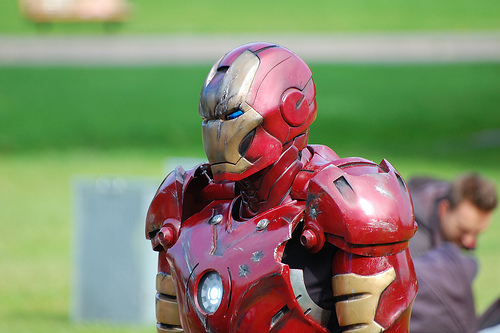In The XOS-2, A Leaner, Meaner Fighting Machine

And this time, the device is real, and the man behind the suit is not played by the dashing Robert Downey Jr.
Released this week, the XOS-2 Exoskeleton is the sequel to the original full-body super-suit developed in 2008 that behaves much like the one in the Iron Man movies.
For those of you unfamiliar with the most mainstream of Downey Jr.’s cinematic enterprises, the suit invented by the main character of the movie sports numerous technological gadgets and weaponry, has superhuman strength and provides other useful accessories for fighting crime and aiding the military.
Produced by Steve Jacobsen and the employees at the robotics company Sarcos (purchased by Raytheon in November 2007), the XOS-2 Exoskeleton is all about downsizing from the original model—in a good way.
The Exoskeleton is being designed for military and construction use, enabling the user to perform the work of up to three men without tiring. It also helps move heavy objects too cumbersome to move without the suit.
Version 2.0 requires a lot less output from the user; the upgraded suit is 10 percent lighter, at around 195 pounds, and requires 50 percent less energy and significantly less muscle to lift it.
One of the outstanding differences in the new model is the weight ratio. Lifting things in the suit is much easier because it makes object feel lighter.
In the XOS-2, the ratio between actual and perceived weight lifted is 17:1, a vast improvement to the 6:1 XOS-1 ratio. Roughly translated, 200 pounds only feels like 12 pounds, and 50 pounds only feels like three pounds.
Suit test engineer Rex Jameson said he used the suit to repeatedly lift a 200-pound artillery shell and punch it through four one-inch boards strapped together.
Jacobsen himself has lifted a 200-pound weight over 500 times in the suit while testing out its capabilities.
However, the project is not without its obstacles.
Finding a power source for the super suits has been difficult because the power is derived through a cable, limiting the movement of the suits to a small radius.
Funding has also been a challenge.
The project receives anywhere between $4 million and $8 million from the Pentagon's Defense Advanced Research Projects Agency (DARPA), but the government has yet to approve other means of funding for developing the suits for unknown reasons.
Jacobsen and the engineers at Sarcos-Raytheon hope that one day, the suits can be used to aid soldiers and construction workers, protect firemen and mobilize the disabled.
Imagine how this invention could change the face of our reality. Metal-clad super soldiers sprinting through gunfire, leaping through flames into a burning house, or on a track, competing in the Olympics presents a whole new level of possibilities.
Soldiers haven’t had a chance to test it out yet, but when that day comes, the face of warfare will change.
Can you think of other ramifications of this suit? Will it alter the world as we know it forever?
To watch a video of the suit being used, click here.
To look at a photo gallery for the suit, click here.
To reach reporter Lindy Tolbert, click here.



